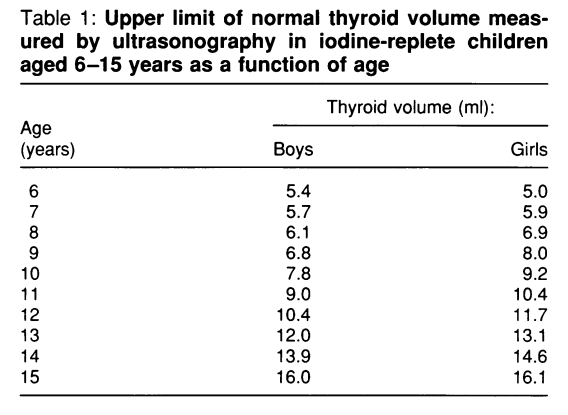Right Lobe:
Length (cm):Width (cm):
Depth (cm):
Left Lobe:
Length (cm):Width (cm):
Depth (cm):
Results:
Thyroid volume as per correction factor 0.479:
Calculated volume of the right lobe (ml):Calculated volume of the left lobe (ml):
Thyroid volume as per correction factor 0.529:
Calculated volume of the right lobe (ml):Calculated volume of the left lobe (ml):
Key Takeaways
- The limits of normal thyroid volume (excluding isthmus, unless its thickness is >3 mm) are 10-15 ml for females and 12-18 ml for males.
- Accurate evaluation of thyroid volume is crucial for diagnosing goiter and monitoring thyroid diseases, particularly in pediatrics.
- Various methods are used to estimate thyroid size and volume, but sonographic volumetry is more accurate than physical examination.
- Factors such as age, sex, weight, height, body mass index, and body surface area can affect thyroid volume.
Introduction
Accurate evaluation of thyroid volume is essential for diagnosing goiter and monitoring thyroid diseases. This is particularly important in pediatrics, as linear measurements of the developing thyroid gland do not correlate well with age, sex, or body composition variables. Inaccurate estimation of thyroid size and volume can lead to false-positive or false-negative diagnoses of thyromegaly, resulting in unnecessary or delayed care.
Methods of Thyroid Volume Measurement
Various methods are used to estimate thyroid size and volume. Physical examination, including visual inspection and palpation, is commonly used but has low sensitivity and specificity. Sonographic volumetry is a more accurate method of assessing thyroid size compared to physical examination.
Sonographic features, such as high-resolution gray-scale imaging and Doppler techniques, are used to evaluate the position, shape, size, content, echogenicity, and vascularity of the thyroid gland. High-resolution linear transducers are commonly used for thyroid sonography. In cases of severe enlargement or retrosternal extensions of the gland, convex or sector probes can be used to document the entire extent of the thyroid.
A standardized thyroid sonographic report should include the measurement of three linear dimensions for each lobe: length (L), anterior-posterior (A-P) diameter, and width (W). These measurements are obtained using sagittal and transverse views. The volume (V) of each lobe can be automatically calculated using the ellipsoid equation with a correction factor. The total thyroid volume is then calculated by summing the volumes of the right and left lobes. The anterior-posterior dimension of the isthmus is also recorded.
Formula for Thyroid Volume Calculator on Ultrasound, MRI or CT:
Volume of each thyroid lobe = Length (L)x anterior-posterior (A-P) diameter x and Width (W) x Correction Factor
Correction factors as per different studies:
Old WHO study: 0.479
New study by Shabana et. al. in AJR: 0.529
You then add the volume for each lobe to get the total thyroid volume.
Factors Affecting Thyroid Volume
Several factors can affect the size of the thyroid gland. Age, sex, weight, height, body mass index (BMI), and body surface area have been positively correlated with thyroid volume. Diets lacking sufficient iodine and cigarette smoking have also been shown to affect thyroid volume. An enlargement of the thyroid gland is called a goiter, which can be caused by iodine deficiency or autoimmune thyroid disorders. Other factors that can contribute to a goiter include intrinsic thyroid hormone production defects and certain medications.
Clinical Significance of Thyroid Volumetry
Accurate measurement of thyroid volume has clinical significance in various aspects of patient care. It is necessary for surgical planning, calculating the dose of radioactive iodine for thyrotoxicosis treatment, and monitoring the effectiveness of different thyroid therapies. Sonographically measured thyroid volume provides valuable information for physicians in making treatment decisions.
Normal Thyroid Volume
There are no current guidelines in the United States that require the measurement of thyroid volume as part of a sonographic examination. However, normal values for thyroid volume have been established based on age, sex, and body surface area variables. These values vary depending on whether a region is iodine-sufficient or iodine-deficient. In iodine-replete regions of the world, such as the United States, normal thyroid volumes range from 10 to 18 mL for adults. For children and adolescents, reference values based on age and sex can be used to estimate the maximum normal thyroid volume.
The typical size of a thyroid lobe is as follows:
- 18-20 mm in length and 8-9 mm in antero-posterior (AP) diameter for newborns
- 25 mm in length and 12-15 mm in AP diameter at one year old;
- 40-60 mm in length and 13-18 mm in AP diameter for adults.

Conclusion
Accurate evaluation of thyroid volume is crucial for diagnosing goiter and monitoring thyroid diseases. Sonographic volumetry is a more accurate method than physical examination for assessing thyroid size. Factors such as age, sex, weight, height, BMI, body surface area, iodine deficiency, and smoking can affect thyroid volume. Incorporating thyroid volume measurement into routine sonographic examinations can improve accuracy and clinical value. It is important for healthcare professionals to be aware of normal thyroid volumes based on age, sex, and body surface area variables to ensure accurate diagnosis and treatment decisions.
References:
- Viduetsky A, Herrejon CL. The Importance of Measuring Thyroid Volume by Sonography: A Review. J Diagn Med Sonogr. 2019;35(3):188-196. doi:10.1177/8756479318808395
- Chaudhary, Vikas; Bano, Shahina1. Thyroid ultrasound. Indian Journal of Endocrinology and Metabolism 17(2):p 219-227, Mar–Apr 2013. | DOI: 10.4103/2230-8210.109667
- Shabana, W., Peeters, E., & De Maeseneer, M. Optimal correction factor for thyroid volume assessment using the ellipsoid formula. American Journal of Roentgenology, 185(1), 222-227. doi: 10.2214/AJR.04.1603
- Brunn J, Block U, Ruf G, Bos I, Kunze WP, Scriba PC. Volumetric analysis of thyroid lobes by real-time ultrasound (author’s translation) [in German]. Dtsch Med Wochenschr 1981; 106:1338-1340
- Recommended normative values for thyroid volume in children aged 6-15 years. World Health Organization & International Council for Control of Iodine Deficiency Disorders. Bull World Health Organ. 1997;75(2):95-97.
Check out other radiology calculators:
Radiology Calculators
Disclaimer: The author makes no claims of the accuracy of the information contained herein; this information is for educational purposes only and is not a substitute for clinical judgment.
